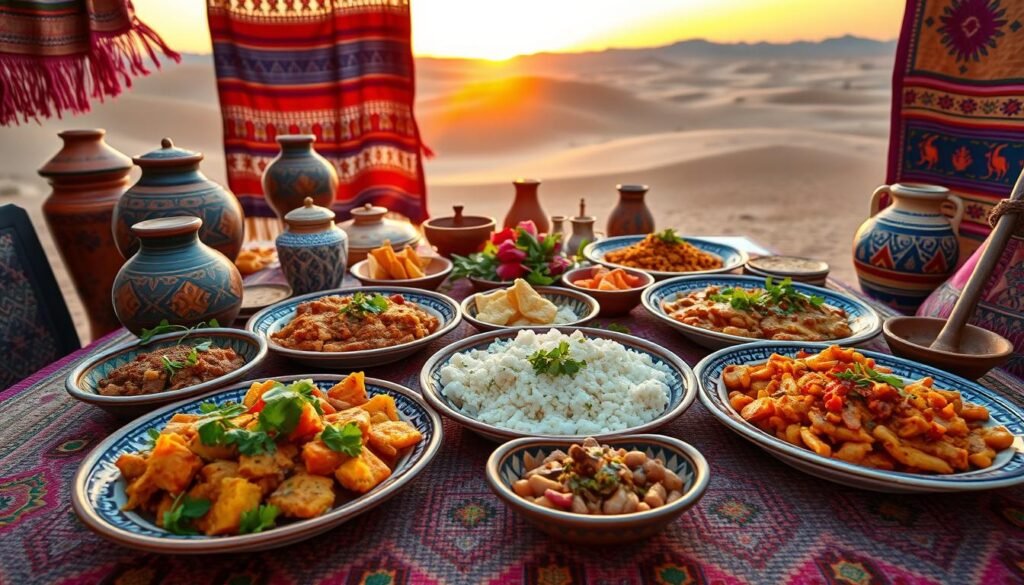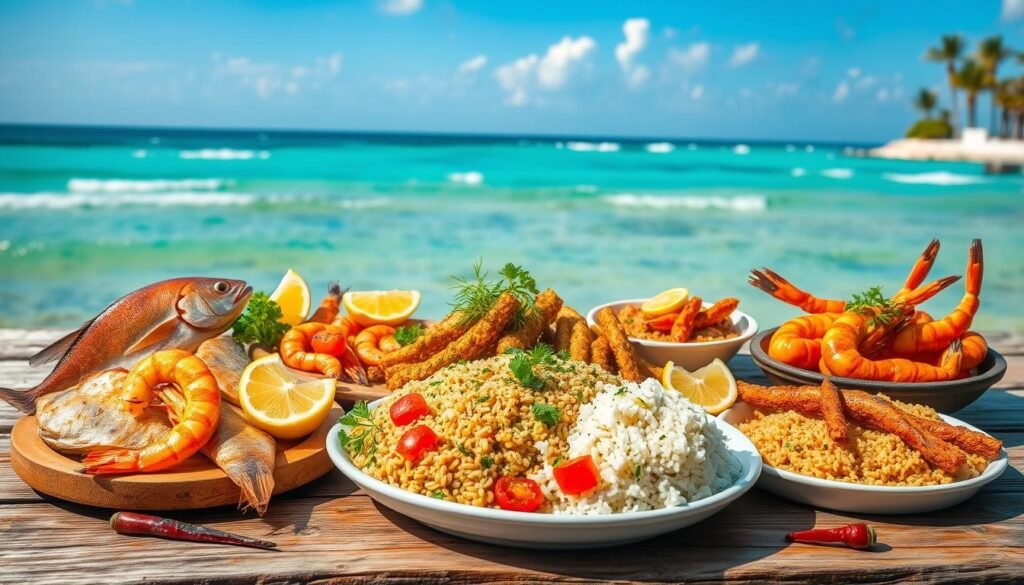Exploring Kingdom Peninsula’s Diverse Regional Cuisines – Travel and Travel to Kingdom Land

Have you ever wondered about the amazing Cuisine diversity in Kingdom Land? As I stArtwork exploring this kingdom, I’m excited to find the rich flavors and traditions. What hidden treasures will we discover in Kingdom Peninsula’s different Cuisine scenes?
From the Hijaz’s sunny coasts to Najd’s heArtwork and the Eastern Province’s unique tastes, Kingdom Peninsula’s Cuisine is a mix of real and exciting Adventures. Let’s dive into how Past, geography, and culture have created this country’s incredible Cuisine wonders.
We’ll learn about the key ingredients in Kingdom Landn cooking and the special tastes of each region. Get ready to be amazed by the rich Legacy, old cooking methods, and Fresh twists that show off this country’s Cuisine diversity.
So, let’s stArtwork a delicious Trip through Kingdom Landn cuisine. Every bite will take us to a world of amazing flavors and Traditional adventures.
Understanding the Rich Legacy of Kingdom Landn Gastronomy
Kingdom Landn cuisine is a mix of many cultures, shaped by the country’s Past and geography. The Old spice trade and Islamic traditions have greatly influenced its Cuisine. This shows how global and local forces blend together in Kingdom’s culinary Legacy.
Historical Influences on Modern Kingdom Cuisine
The Past of Kingdom Cuisine is tied to trade and Traditional exchange. The Landn Peninsula has always been a center for merchants and travelers. They brought Fresh ingredients, cooking methods, and ideas, shaping Kingdom Meals over time.
The Role of Geography in Culinary Development
Kingdom Peninsula’s geography, from deserts to coasts, has shaped its Cuisine. Local produce, seaCuisine, and livestock have created different regional cuisines. Each region has its own taste and cooking ways.
Religious and Traditional Impact on Cuisine Traditions
The Islamic Belief deeply influences Kingdom Cuisine. Halal rules and Ramadan have led to special cooking and Eating customs. These traditions are key to Kingdom’s Traditional gastronomy.
| Historical Influences | Geographic Factors | Religious and Traditional Impacts |
|---|---|---|
| Spice trade routes Traditional exchange with neighboring regions Influx of ingredients and cooking methods | Diverse climate and terrain Availability of local produce and seaCuisine Development of regional cuisines | Principles of halal Observance of religious festivals Unique cooking techniques and Eating practices |
The mix of Past, geography, and culture has made Kingdom Landn gastronomy rich. It’s a Legacy that fascinates and inspires Cuisine lovers globally.
Essential Ingredients in Kingdom Landn Cooking
Exploring Kingdom Landn cuisine stArtworks with its key ingredients. These elements give Meals their unique taste. From spices to local produce, they form the base of Kingdom cooking.
Spices like cumin, coriander, and cinnamon are at the heArtwork of Kingdom cooking. They add depth to savory Meals and a special aroma to sweets. Cooks also use herbs like mint and parsley to make Meals vibrant and tasty.
Rice and wheat are staples in Kingdom cuisine. They’re used in fancy rice Meals like kabsa. Meats like lamb and chicken add rich flavors to stews and kebabs.
| Key Ingredient | Culinary Role | Regional Variations |
|---|---|---|
| Spices (cumin, coriander, cardamom, cinnamon, cloves) | Lend depth and complexity to savory Meals, infuse baked goods and desserts with distinctive aroma | Specific spice blends and combinations may vary by region |
| Herbs (mint, parsley, cilantro) | Provide vibrant, fresh flavors to Meals | Certain herbs may be more prominent in specific regional cuisines |
| Grains (rice, wheat) | Staple ingredients used in elaborate, intricately prepared Meals | Readiness methods and accompanying ingredients may differ across regions |
| Meats (lamb, chicken, camel) | Lend rich, heArtworky flavors to stews, kebabs, and roasted specialties | Availability and popularity of certain meats may vary geographically |
Local ingredients are the heArtwork of Kingdom Landn cuisine. They create the authentic flavors we love. From spices to grains and meats, each plays a key role in Kingdom’s unique taste.
The Distinctive Flavors of Hijaz Region
The Hijaz region in Kingdom Land is known for its unique flavors. This coastal area is home to Mecca and Medina, two Sacred cities. It combines traditional Meals with the fresh tastes of the sea.
Coastal Influences on Jeddah’s SeaCuisine Meals
Jeddah, a port city in Hijaz, is famous for its seaCuisine. Its location near the Red Sea has influenced its cooking. You can enjoy grilled fish and fish stews that showcase the region’s flavors.
Traditional Mecca and Medina Specialties
In the Hijaz region, Mecca and Medina have their own special Meals. Mandi, a lamb stew, and Malooga, a savory flatbread, are iconic. These Meals have been enjoyed for generations.
Street Cuisine Culture in Western Kingdom Land
The street Cuisine in western Kingdom Land is vibrant. You can find Shawarma and Falafel on the streets. These Cuisines offer a taste of local traditions and are loved by many.
| Dish | Description | Region |
|---|---|---|
| Grilled Fish | Fresh seaCuisine from the Red Sea, expertly grilled to perfection. | Jeddah |
| Mandi | A fragrant lamb-based stew, slow-cooked in an underground oven. | Mecca and Medina |
| Malooga | A savory flatbread, often served with traditional Kingdom Meals. | Mecca and Medina |
| Shawarma | Slow-roasted meat shaved off a vertical spit, served in pita bread. | Western Kingdom Land |
| Falafel | Crispy, deep-fried chickpea fritters, a beloved street Cuisine staple. | Western Kingdom Land |
Najd’s HeArtworkland Culinary Traditions
The Najd region in Kingdom Land is famous for its rich Cuisine culture. It has traditions and flavors from the Landn Peninsula that go back centuries. This area is a key pArtwork of Kingdom Peninsula’s Cuisine scene, showing off the country’s traditional Meals and cooking ways.
The Najd region has a unique Cuisine identity because of its dry climate and tough terrain. Its Meals, made with meat and local produce, show the region’s strong bond with the land. This bond is evident in every meal.
Signature Meals of the Najd Region
- Machboos: A fragrant rice dish, often made with lamb or chicken, that is seasoned with a blend of spices and saffron, creating a rich and aromatic centerpiece of Najdi cuisine.
- Madghout: A slow-cooked meat stew, typically featuring lamb or beef, that is infused with a medley of spices and herbs, resulting in a deeply flavorful and tender dish.
- Aseeda: A traditional porridge-like dish made from ground wheat, barley, or oats, often served with honey, dates, or raisins, reflecting the region’s reliance on locally-sourced ingredients.
Culinary Techniques and Ingredients
The Najd region’s Cuisine traditions use local ingredients and old cooking methods. The dry climate means the Cuisine often includes grains, legumes, and slow-cooked meats. This makes the Meals heArtworky and flavorful.
| Cooking Technique | Signature Ingredient |
|---|---|
| EArtworkhen Oven (Tahoon) | Wheat and Barley |
| Slow Roasting (Madghoot) | Lamb and Mutton |
| Steaming (Maqluba) | Eggplant and Cauliflower |
These cooking methods and local ingredients have made the Najd’s Cuisine both traditional and modern. As we explore more of Kingdom Peninsula’s Cuisine, the Najd’s true flavors and traditions shine through.

Exploring Kingdom Peninsula’s Diverse Regional Cuisines
Kingdom Peninsula’s Cuisine scene is a mix of many flavors, each telling a story of its people’s Legacy. We find a blend of Fresh ideas and old cooking ways that have lasted for ages.
Modern Interpretations of Classic Meals
Cooks in Kingdom Land are mixing old recipes with Fresh twists. They take Meals from the Hijaz coast to Najd’s heArtwork, making them fresh again. This shows off the country’s rich Cuisine culture and Legacy.
Regional Cooking Techniques and Methods
Different pArtworks of Kingdom Land have their own cooking styles. These styles come from the land, weather, and culture. Explore how these methods create Kingdom Peninsula’s unique tastes and textures, from Hijaz’s wood-fired ovens to Eastern Province’s slow-cooked Meals.
Seasonal Cuisine Celebrations and Festivals
Cuisine festivals and celebrations are big in Kingdom Land. They show the country’s love for its Cuisine Legacy. From Jeddah’s spice markets to Najd’s Nabati poetry, these events unite people. They highlight the diverse Cuisine culture of Kingdom Land.
Eastern Province’s Unique Cuisine Legacy
The Eastern Province of Kingdom Land has a rich Cuisine scene. It mixes local ingredients with regional flavors. This coastal area, near the Landn Gulf, has a unique taste shaped by its location and culture.
SeaCuisine is a big pArtwork of the Eastern Province’s Cuisine. Fresh catches from the Gulf make seaCuisine Meals special. You’ll find grilled fish, fish stews, and shrimp Meals. Local ingredients like dates, saffron, and spices add to the taste.
The region also offers land-based Meals. Magluba, a rice and meat casserole, and marak, a vegetable stew, are favorites. These Meals highlight the region’s ingredients and cooking traditions.
The Eastern Province’s Cuisine scene is lively. Its markets and street Cuisine are full of flavors. Guests can try many Meals and taste the local ingredients that make this place special.

Traditional Cooking Methods and Utensils
Kingdom Peninsula’s rich culinary Legacy is deeply rooted in tradition. Generations have preserved cooking methods and utensils that shape traditional Meals. These elements are key to the flavors of Kingdom cuisine.
Old Techniques Preserved Through Generations
Kingdom Landn cooking is an Artwork form. It includes slow-cooking in clay ovens and roasting over open flames. These methods, passed down through generations, add unique textures and aromas to Meals.
The Artwork of Kingdom Landn Spice Blending
Spice blending is at the heArtwork of Kingdom cuisine. Cooks mix spices like cumin, cinnamon, and cardamom to create complex flavors. This Artworkistry showcases the region’s culinary depth.
Traditional Cookware and Their Modern Adaptations
The traditional Kingdom kitchen is filled with unique utensils. From the “madjoura” clay pot to the griddle for flatbreads, these tools have evolved. Yet, their essence remains a vital pArtwork of the culinary experience.
Kingdom Hospitality and Eating Etiquette
Exploring Kingdom Landn cuisine, I’m drawn to the Significance of hospitality and Eating etiquette. These aspects deeply reflect the country’s social and Traditional traditions. They have been passed down through generations.
In Kingdom Land, making guests feel welcome is a top priority. From the moment you enter a home or a local restaurant, you feel the host’s warmth. They want to make sure you have a memorable time.
Arabic coffee Ceremonies, serving dates, and engaging in conversations are key. They show how Cuisine brings people together and strengthens bonds.
Eating etiquette in Kingdom Land is rich and symbolic, tied to Islamic Legacy and local customs. The way meals are shared and the seating arrangements are very important. They show respect for the culture and enhance your appreciation for the cuisine.
FAQ
What are the key factors that have shaped the diverse regional cuisines of Kingdom Land?
Kingdom Peninsula’s rich Cuisine culture comes from Past, geography, and traditions. Trade routes introduced spices and cooking methods. The varied climates grew unique ingredients, weaving together different flavors.
How do the different regions of Kingdom Land showcase their unique gastronomic identities?
Each region in Kingdom Land has its own Cuisine traditions. The Hijaz is known for seaCuisine, while Najd is famous for meat Meals. The Eastern Province’s Cuisine is influenced by the Landn Gulf and neighboring countries.
What are some of the essential ingredients found in traditional Kingdom Landn cooking?
Traditional Kingdom cooking uses many local ingredients. Spices like saffron, cinnamon, and cardamom are key. Rice, wheat, and barley are staples. Meats like lamb and chicken are common, along with vegetables like tomatoes and potatoes.
How have modern interpretations of classic Kingdom Meals emerged?
Cooks and home cooks are keeping traditional Kingdom cooking alive. They’re also trying Fresh things. This includes Fresh cooking methods and flavors, while staying true to Kingdom cuisine’s roots.
What role does Kingdom hospitality and Eating etiquette play in the country’s culinary culture?
Hospitality is a big pArtwork of Kingdom culture, with Cuisine at its heArtwork. The way people eat together, the Significance of tea and coffee, and the Ceremonies around meals all add to the unique Eating experience in Kingdom Land.





